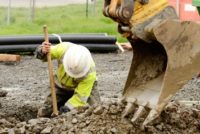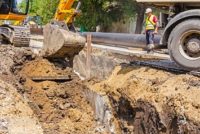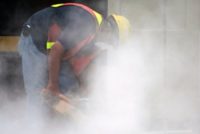Protecting workers from the hazards of trenches has lately been front and center in OSHA’s outreach to employers. One critical step in ensuring that you are meeting your obligations to protect employees who dig and work in trenches is to have a solid knowledge of how to classify soils. The Agency has produced an 11-minute […]
Pneumatic nail guns (PNGs) are formidable machines powered by air compressors that with a single trigger activation enable nails to be completely driven into hardwood floors, framing lumber, plywood sheathing, and roof substrates. When used properly, PNGs boost productivity, particularly in home construction. However, the power and speed inherent in these tools have led to […]
In a recent news release, OSHA announced the development of a series of compliance assistance resources to help keep workers safe from trenching and excavation hazards. OSHA’s goal is to increase awareness of trenching hazards in construction, educate job creators and workers on safe cave-in prevention solutions, and decrease the number of trench collapses. These […]
The latest trend in safety for construction workers may have been established by a New York City (NYC) law signed by Mayor Bill de Blasio in October 2017. Local Law 196 established new training requirements for employees at certain construction jobsites. The requirement—a minimum number of hours of training on specific safety subjects for workers […]
Do you know the difference between what is considered construction or maintenance? The type of work performed dictates what standards you need to follow. Use this infographic to find out if your task is considered construction or maintenance.
A Centers for Disease Control and Prevention (CDC) study that examined unintentional or undetermined overdose deaths in 26 occupation groups found that construction occupations had the highest proportional mortality rates (PMRs) of deaths from both heroin and prescription opioids.
OSHA recently provided guidance about several frequently asked questions about the respirable crystalline silica rule in construction, along with a new set of videos on controlling silica dust generated by several types of equipment.
OSHA’s illumination standards for construction (29 CFR 1926.56) and shipyard employment (29 CFR 1915.82) are intended to ensure that specific work areas or areas where workers are stationed or passing through are provided with lighting that is sufficient to enable the workers to see hazardous conditions and avoid injury. The standards set minimum lighting requirements […]
On Monday, three news releases from OSHA covered recent enforcement actions. Two of them were taken against construction companies that failed to protect employees from trenching hazards, and one of the enforcement actions was unfortunately taken only after two employees were killed.
Struck-by object is one of OSHA’s Construction Focus Four topics (along with falls, electrocution, and caught-in-between), collectively the four hazards that year-to-year result in more than half the fatalities in the construction industry.










